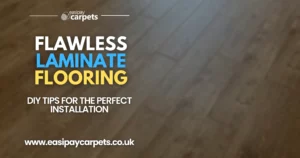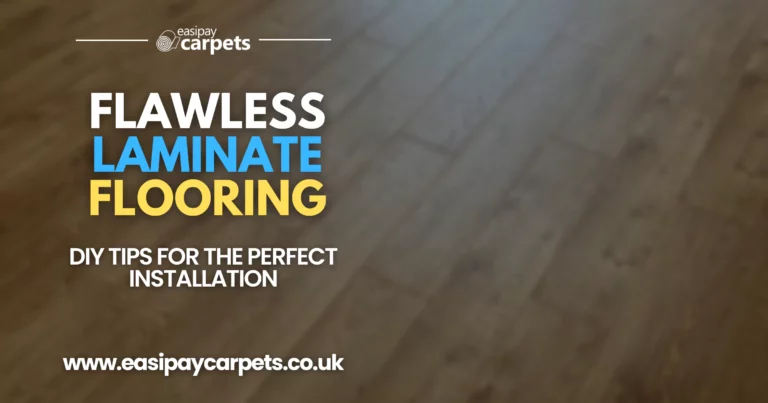

A Step-by-Step Guide to Perfect Laminate Flooring Installation
Tips for a Flawless Laminate Flooring Installation
Laminate flooring is a stylish, durable, and budget-friendly choice for homes, making it a popular option for DIY enthusiasts. However, achieving a flawless installation requires careful preparation, the right tools, and attention to detail. Whether you’re a first-time installer or looking to perfect your technique, these expert tips will help you achieve professional results.
1. Choose the Right Laminate Flooring
Before installation, ensure you’ve selected the best laminate for your needs.
- Consider Room Traffic: High-traffic areas like hallways and kitchens need a durable, high-AC (Abrasion Class) rating.
- Water Resistance: Choose water-resistant laminate for kitchens, bathrooms, or areas prone to spills.
- Colour and Finish: Lighter colours can make rooms appear larger, while textured finishes add a realistic wood feel.
2. Acclimate the Laminate Flooring
Laminate flooring expands and contracts with temperature and humidity changes, so it must adjust to the room’s conditions before installation.
- Leave the unopened laminate packs in the room for 48 hours before installation.
- Keep the temperature between 18-24°C (65-75°F) and humidity stable.
- Lay the boxes flat to prevent warping.
3. Prepare the Subfloor Properly
A smooth and stable subfloor is essential for a flawless installation.
- Remove old flooring if necessary and ensure the subfloor is clean, dry, and level.
- Check for moisture if installing over concrete. Use a moisture barrier if needed.
- Fill any gaps or uneven spots with a floor levelling compound.
4. Use the Right Underlay
Underlay improves soundproofing, insulation, and comfort underfoot.
- Foam Underlay: Best for standard rooms without moisture concerns.
- Combination Underlay: Includes a built-in moisture barrier for damp areas like basements.
- Soundproofing Underlay: Ideal for apartments or multi-level homes to reduce noise.
5. Plan Your Layout Before Installing
Proper planning ensures a seamless finish.
- Measure the room carefully to determine how many planks you need.
- Decide on the plank direction—running planks parallel to the longest wall often looks best.
- Stagger plank seams in a brickwork pattern for a natural look and structural stability.
- Leave an expansion gap of at least 10mm around the room’s edges to prevent warping.
6. Cut Laminate Planks Correctly
Accurate cutting prevents gaps and misalignment.
- Use a fine-tooth blade on a circular saw, jigsaw, or laminate cutter to avoid chipping.
- Measure twice, cut once to prevent mistakes.
- Cut with the decorative side up to reduce splintering.
- For complex cuts around pipes or doorways, use a jigsaw for precision.
7. Install the First Row with Precision
The first row sets the foundation for a perfect installation.
- Start against a straight wall and ensure the first row is level.
- Use spacers to maintain the expansion gap along the walls.
- Trim the first row if necessary so the last row isn’t too narrow.
8. Use the Click-Lock System Correctly
Most modern laminate flooring features a click-lock system for easy installation.
- Insert the planks at an angle and gently press down until they lock in place.
- Use a tapping block and mallet to secure planks without damaging the edges.
- Avoid forcing planks together—if they don’t lock easily, check for debris in the grooves.
9. Pay Attention to the Last Row
The final row should fit snugly without leaving large gaps.
- Measure and cut the last row carefully to ensure an even finish.
- Use a pull bar to fit the last planks tightly against the previous row.
- Re-check the expansion gap before securing the final pieces.
10. Finish with Skirting Boards or Beading
Covering the expansion gap ensures a professional-looking finish.
- Install skirting boards or beading along the room’s edges.
- Avoid nailing directly into the laminate—fix skirting to the wall instead.
- Use a flexible sealant for extra moisture protection in kitchens or bathrooms.
11. Clean Up and Inspect Your Work
Once installation is complete, do a final check to ensure everything is secure.
- Remove any dust or debris with a soft broom or vacuum.
- Wipe down the surface with a damp (not wet) mop.
- Walk across the floor to check for any loose planks or movement.
Common Mistakes to Avoid
- Skipping the expansion gap: Laminate expands and contracts, so always leave a 10mm gap.
- Forgetting underlay: Without underlay, your floor may feel hard and noisy.
- Not staggering the planks: Rows should be offset for structural stability and a natural look.
- Using too much force: Click-lock planks should snap together smoothly—if they don’t, check for debris or alignment issues.
- Ignoring moisture concerns: If installing in damp areas, use moisture-resistant underlay and seal edges properly.
Conclusion
Installing laminate flooring can be a rewarding DIY project with the right preparation and techniques. By acclimating your flooring, preparing the subfloor, using the correct tools, and following a careful installation process, you can achieve a flawless, professional-looking result. With these expert tips, your laminate floor will be durable, stylish, and long-lasting.
Are you on the hunt for new flooring? With Easipay Carpets you can get the flooring of your dreams from as little as £10 per week, completely interest free! We offer Carpets, Vinyl and Laminate flooring with free underlay, door bars, carpet grippers and beading wherever needed on payment plans that spread the cost of the flooring into smaller, more manageable payments. Find out more at the button below!
Still Got Questions? Here's 10 FAQs!
Yes, leave laminate flooring in the room for at least 48 hours to adjust to temperature and humidity.
Use a circular saw, jigsaw, or laminate cutter with a fine-tooth blade to avoid chipping.
Yes, as long as the surface is clean, level, and moisture-free.
A 10mm (⅜ inch) expansion gap is recommended around all walls and fixed objects.
Without underlay, laminate flooring may feel uncomfortable underfoot and produce more noise. If your subfloor underneath is concrete it also allows moisture to rise through the concrete and degrade the laminate – installing a waterproof underlay will prevent this.
Use spacers during installation and ensure planks are locked properly.
Yes, but choose water-resistant laminate and seal all edges with waterproof sealant.
Our favourite flooring for bathrooms is SPC (Stone Plastic Composite) which looks like laminate flooring but is completely waterproof. A cheaper option is sheet vinyl flooring which is also waterproof, though the edges of the room must still be sealed.
Use a tapping block and mallet to gently close gaps.
Yes, if it’s a floating floor. If adhesive was used, wait 24 hours for it to set.
Use a lightly dampened (not wet) mop and a pH-neutral laminate cleaner.




